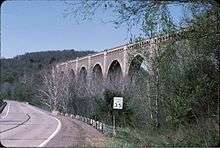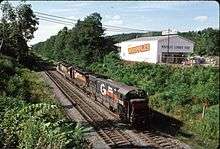Nicholson Cutoff
The Nicholson Cutoff (also known as the Clark's Summit-Hallstead Cutoff) was built by the Lackawanna Railroad to replace the original Lackawanna line between Clarks Summit, PA, and Hallstead, PA. In surveying potential routes for the new line, the Lackawanna investigated the possibility of building a line directly from Clarks Summit to Nichols, NY, bypassing Binghamton, NY. This alignment would have shaved 20 miles (32 km) off the existing route between these two points, but was deemed impractical not only because it would have bypassed a major junction point on the railroad, but also because of the amount of cutting and filling that would have been needed to build this route. As about half of the old line was curved track, a major rationale for building the new line would be to "straighten-out" the route. The new route, the cutoff, would ultimately eliminate two-thirds of this curvature, 2400 degrees, the equivalent of more than six and a half circles. Nearly all the remaining curves would be 2° (2,864.75 ft or 873.18 m radius) or less, permitting 70 mph (113 km/h) or greater for passenger trains. This was a decided improvement over the curves on the old route, some of which exceeded 6° (955.37 ft or 291.20 m radius, restricting trains to 35 mph or 56 km/h).
Construction on the Nicholson Cutoff started in May 1912 and the first revenue train to run over the line was on November 6, 1915. While the new 39.6-mile (63.7 km) line resulted only in a modest savings in travel distance (3.6 miles or 5.8 km) the cutoff saved a significant amount of travel time between Scranton, PA, and Binghamton, NY, especially for freight trains. Before the building of the cutoff, heavy westbound coal trains, bringing anthracite coal from Scranton, required pushers to be added in three different locations—LaPlume, Nicholson, and Hallstead—once they got past the top of the grade at Clarks Summit. The new line eliminated the need for these additional engines and crews, not to mention that these trains no longer needed to stop for the pushers to be added.[1]
The Cutoff was built in a manner similar to that of the Lackawanna Cut-Off in New Jersey that had opened in December 1911. This is not surprising as the chief civil engineer on both projects was George J. Ray. But unlike the New Jersey Cut-Off, which used reinforced concrete in all its structures, the Pennsylvania Cutoff used other materials (such as bricks) as well. Indeed, the brick-lined Nicholson Tunnel (3,629 feet or 1,106 m long, located at Milepost 160) is the only tunnel on the cutoff, and the only brick-lined tunnel ever constructed by the Lackawanna. Nevertheless, the most significant structures on the line, the viaducts at Nicholson, PA and Martins Creek, PA, were built of reinforced concrete. The Tunkhannock Viaduct at Nicholson, the line's namesake, is considered to be the world's largest concrete structure. Built with approximately 700,000,000 pounds (320,000,000 kg) of concrete, its ten spans go 60 feet (18.29 m) below ground-level to bedrock, making the center span of the bridge effectively 300 feet (91 m) tall. Over the years, Nicholson Viaduct would become a symbol of the engineering accomplishments of the Lackawanna.[2]
The Nicholson Cutoff was later used for freight trains of Canadian Pacific Railway. In 2015, Norfolk Southern Railway took over operations.[3]
Notes
- ↑ Taber & Taber 1980
- ↑ Taber & Taber 1980
- ↑ "Norfolk Southern completes acquisition of Delaware & Hudson South Line". PRNewswire (Press release). September 18, 2015.
References
- Taber, Thomas Townsend; Taber, Thomas Townsend III (1980). The Delaware, Lackawanna & Western Railroad in the Twentieth Century. 1. Muncy, PA: Privately printed. ISBN 0-9603398-2-5.

